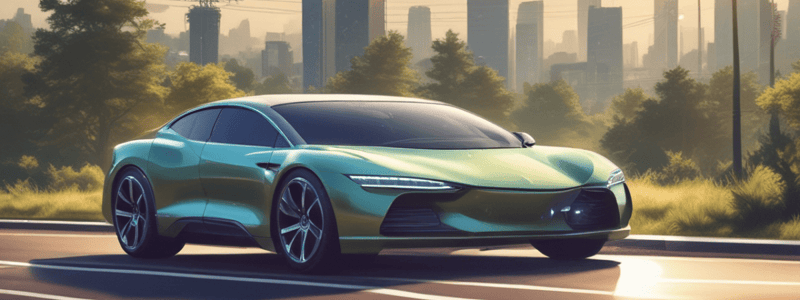Podcast
Questions and Answers
What is an Extended Range EV primarily powered by?
What is an Extended Range EV primarily powered by?
- An internal combustion engine and a small electric motor
- Only an internal combustion engine
- An electric motor and a small internal combustion engine (correct)
- Only an electric motor
What is the primary risk related to Lithium-Ion Batteries (LIBs)?
What is the primary risk related to Lithium-Ion Batteries (LIBs)?
- Short circuit
- Thermal runaway (correct)
- Overcharging
- Electrical shock
What is the purpose of regenerative braking in a Plug-in Hybrid Vehicle?
What is the purpose of regenerative braking in a Plug-in Hybrid Vehicle?
- To generate additional power for the internal combustion engine
- To capture energy during deceleration and store it in the batteries (correct)
- To improve the vehicle's acceleration
- To reduce the vehicle's fuel efficiency
What is the definition of an Electric Vehicle (EV)?
What is the definition of an Electric Vehicle (EV)?
What is an Energy Storage System (ESS)?
What is an Energy Storage System (ESS)?
What type of vehicle is a Plug-in Hybrid Vehicle?
What type of vehicle is a Plug-in Hybrid Vehicle?
How many types of Energy Storage Systems (ESS) are there?
How many types of Energy Storage Systems (ESS) are there?
What is the trend of the use of LIBs as a source of power for consumer vehicles and/or large fleet vehicles?
What is the trend of the use of LIBs as a source of power for consumer vehicles and/or large fleet vehicles?
What is one of the hazards associated with damaged batteries?
What is one of the hazards associated with damaged batteries?
What is a potential risk when responding to electric vehicle fires?
What is a potential risk when responding to electric vehicle fires?
Why should responders wear full PPE when working in a controlled area?
Why should responders wear full PPE when working in a controlled area?
What can occur when a Lithium-Ion Battery (LIB) ruptures?
What can occur when a Lithium-Ion Battery (LIB) ruptures?
What should responders do when arriving at an electric vehicle fire?
What should responders do when arriving at an electric vehicle fire?
What is a characteristic of electric vehicle fires?
What is a characteristic of electric vehicle fires?
What is a common issue with electric vehicle fires?
What is a common issue with electric vehicle fires?
Why should responders not touch the service plug?
Why should responders not touch the service plug?
What type of fires can occur in electric vehicles?
What type of fires can occur in electric vehicles?
What is the purpose of an emergency cut loop in electric vehicles?
What is the purpose of an emergency cut loop in electric vehicles?
Flashcards are hidden until you start studying
Study Notes
Electric Vehicles (EVs)
- Defined as vehicles powered by an electric motor that draws electricity from a battery, which can be charged from an external source
- Includes both all-electric vehicles and plug-in hybrid vehicles
Types of Electric Vehicles
- Extended Range EV: has a small internal combustion engine to generate additional electric power
- Plug-in Hybrid Vehicle: battery is recharged by regenerative braking or a plug-in charging station
Thermal Runaway
- A phenomenon in which a lithium-ion cell enters an uncontrollable, self-heating state
- Can result in dispersion of gases, ejection of shrapnel and particulates, fire, and deflagration
Energy Storage Systems (ESS)
- A battery or group of batteries assembled to store energy to supply electrical energy at a later time
- Four types: walk-in container systems, outdoor cabinet, indoor facility, and large and small vehicle batteries
Hazards of Lithium-Ion Batteries (LIBs)
- May rupture and disperse toxic flammable gases and explode violently when ignited
- Hazards include thermal conditions, physical damage, and electrical issues
- Produce flammable and toxic gases, including hydrogen fluoride and phosphorus pentafluoride
- Can re-ignite unexpectedly, even after all visible fire has been extinguished
Safety Considerations for Responders
- Always wear full PPE, including SCBA, when working in a controlled area
- Ensure vehicle is in park and turned off, and chock the wheels
- Avoid touching the service plug, which poses a high risk of electrocution
- Be aware of multiple classes of fires, including Class A, B, C, and D
- Risks for responders include electrical shock, high temperatures, toxic fumes, lithium burns, toxic runoff, and re-ignition
Studying That Suits You
Use AI to generate personalized quizzes and flashcards to suit your learning preferences.




